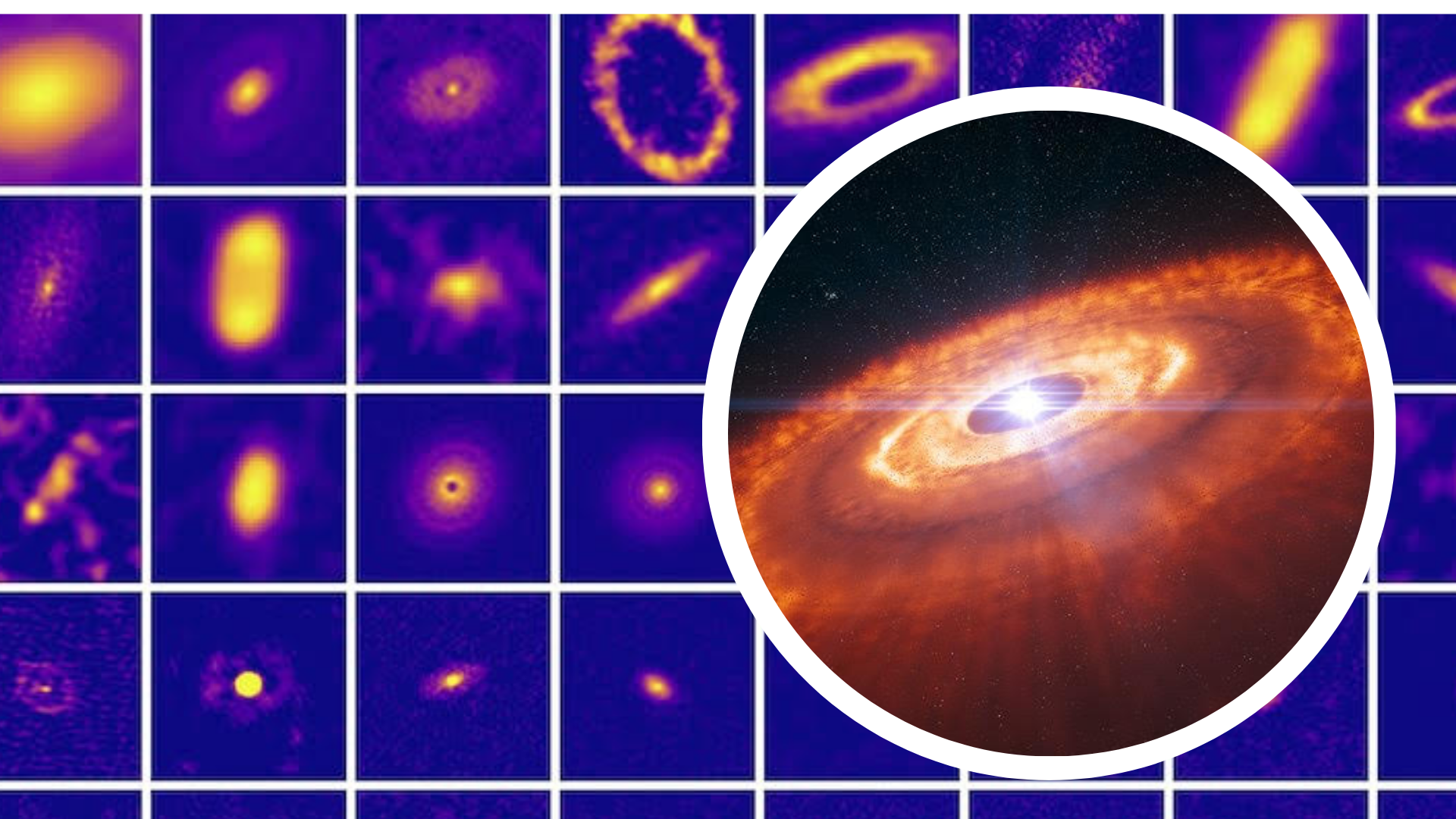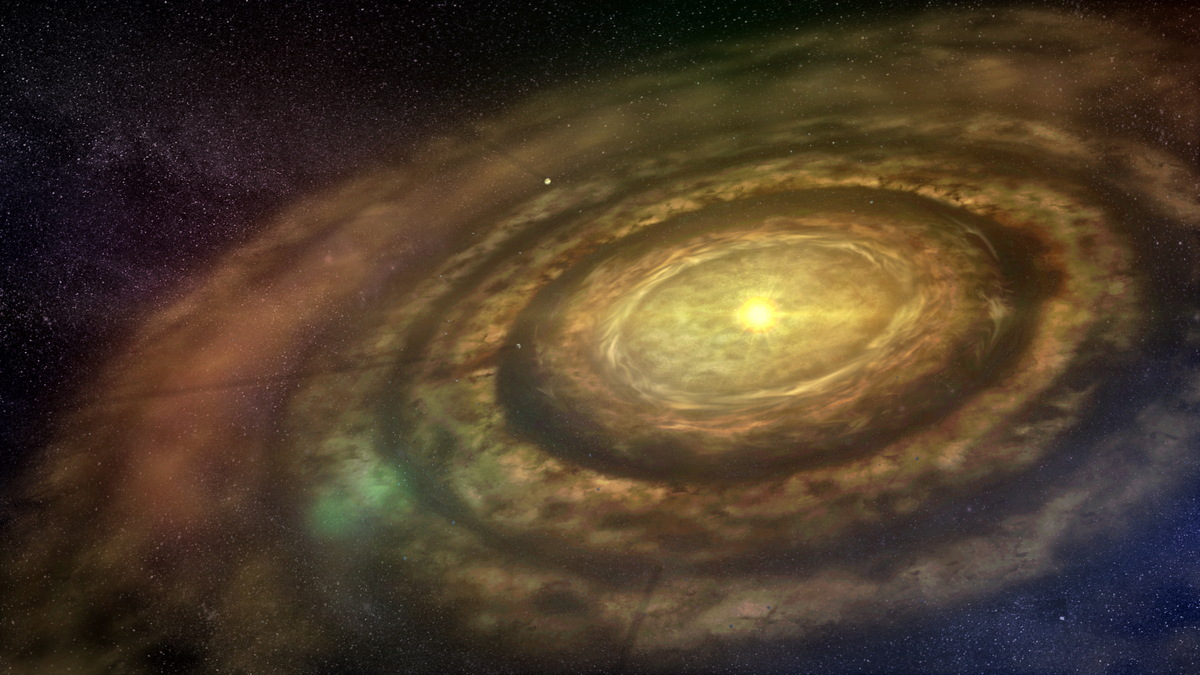
Astronomers have discovered that the flattened clouds of gas and dust around stars — nurseries that give birth to planets — are generally smaller than previously thought. Some are so small, in fact, they would neatly slot within Earth's orbit around the sun.
Additionally, the team's observations, conducted with the Atacama Large Millimeter/submillimeter Array (ALMA), have revealed that these so-called "protoplanetary disks" are more common than scientists had theorized, with small red dwarf stars also able to host them.
The astronomers studied 73 protoplanetary disks in the Lupus region, a prominent star-forming section in space that's located around 400 light-years from Earth in the constellation Scorpius. The team discovered many young stars hosting tiny protoplanetary disks, some not much thicker than the distance between Earth and the sun (an astronomical unit, or AU).
"It is astonishing to discover that protoplanetary disks can be so small and that they are so common," Paola Pinilla, a study team member and researcher at the University College of London (UCL) Mullard Space Science Laboratory, told Space.com. "As the large and bright disks are the easiest to observe, our previous view of the birth site of planets was biased."

The team also found that most of the observed disks showed neither gaps nor rings.
Pinilla added that, thanks to the incredible capabilities of ALMA, astronomers are finally able to characterize the small and faint disks around red dwarf stars that are only 10% to 50% the mass of our sun.
"These stars are the most common in our galaxy, so we are finally revealing and understanding the most common conditions for planet formation," Pinilla said.
The ideal conditions for super-Earths
Over the last decade, astronomers have imaged hundreds of protoplanetary disks, finding that, in general, they are so large they would extend out beyond the orbit of Neptune, about 30 AU.
ALMA, an array of 66 radio telescopes located in the Atacama Desert region of Northern Chile, is no stranger to protoplanetary disks. However, this time, the powerful radio telescope has outdone itself, finding large 30 AU-wide planet-birthing structures may actually be uncommon in terms of the overall population of these objects.
"These results completely change our view of what a 'typical’ protoplanetary disk looks like," team leader Osmar Guerra-Alvarado of Leiden University said in a statement. "Only the brightest disks, which are the easiest to observe, show large-scale gaps, whereas compact disks without such substructures are actually much more common."

The discovery of a small protoplanetary disk has implications for the commonality of a particular kind of extrasolar planet, or "exoplanet," called a super-Earth.
These are rocky worlds that are more massive than Earth but smaller than ice giants like Neptune and Uranus.
Super-Earths generally have masses between two and 10 times that of our planet. The new findings could also explain why super-Earths tend to be found around low-mass stars.
"The observations also show that these compact discs could have optimal conditions for the formation of so-called super-Earths, as most of the dust is close to the star, where super-Earths are typically found," team member Mariana Sanchez of Leiden Observatory said in the statement.
These low-mass red dwarfs are the most common stars in the Milky Way and the conditions around them favor super-Earths, making these more massive cousins of our home planet the most common planets in our galaxy.
What size nursery did Earth grow up in?
Our bias toward larger protoplanetary disks is natural. Not only are they better suited to detection, as explained above, but it seems like our own planet grew up in a larger planetary nursery around 4.6 billion years ago.
One clue is the size of the sun, which is between two and 10 times the size of the stars seen with smaller protoplanetary disks.
Secondly, the conditions in which the solar system formed were sufficient to create gas giants like Jupiter and Saturn. The team's observations of small disks imply that they may not be able to birth such large worlds.
"The discovery that the majority of the small disks do not show gaps implies that the majority of stars do not host giant planets," Nienke van der Marel, a team member and researcher at the Leiden Observatory, said in the statement. "This is consistent with what we see in exoplanet populations around full-grown stars. These observations link the disk population directly to the exoplanet population."
Finally, our planetary system lacks a super-Earth, the creation of which seems favored by small protoplanetary disks.
The lasting impact of this research may be the establishment of a "missing link" between observations of protoplanetary disks and observations of different types of exoplanets around stars.
"The research shows that we've been wrong for a long time about what a typical disk looks like," van der Marel said. "Clearly, we've been biased towards the brightest and largest discs. Now we finally have a full overview of discs of all sizes."
The team's research was published on Wednesday (March 26) on the paper repository site arXiv.







